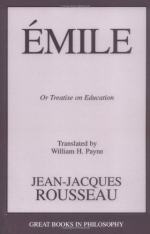You may perhaps suppose that as I am in no hurry to teach Emile to read and write, I shall not want to teach him to read music. Let us spare his brain the strain of excessive attention, and let us be in no hurry to turn his mind towards conventional signs. I grant you there seems to be a difficulty here, for if at first sight the knowledge of notes seems no more necessary for singing than the knowledge of letters for speaking, there is really this difference between them: When we speak, we are expressing our own thoughts; when we sing we are expressing the thoughts of others. Now in order to express them we must read them.
But at first we can listen to them instead of reading them, and a song is better learnt by ear than by eye. Moreover, to learn music thoroughly we must make songs as well as sing them, and the two processes must be studied together, or we shall never have any real knowledge of music. First give your young musician practice in very regular, well-cadenced phrases; then let him connect these phrases with the very simplest modulations; then show him their relation one to another by correct accent, which can be done by a fit choice of cadences and rests. On no account give him anything unusual, or anything that requires pathos or expression. A simple, tuneful air, always based on the common chords of the key, with its bass so clearly indicated that it is easily felt and accompanied, for to train his voice and ear he should always sing with the harpsichord.
We articulate the notes we sing the better to distinguish them; hence the custom of sol-faing with certain syllables. To tell the keys one from another they must have names and fixed intervals; hence the names of the intervals, and also the letters of the alphabet attached to the keys of the clavier and the notes of the scale. C and A indicate fixed sounds, invariable and always rendered by the same keys; Ut and La are different. Ut is always the dominant of a major scale, or the leading-note of a minor scale. La is always the dominant of a minor scale or the sixth of a major scale. Thus the letters indicate fixed terms in our system of music, and the syllables indicate terms homologous to the similar relations in different keys. The letters show the keys on the piano, and the syllables the degrees in the scale. French musicians have made a strange muddle of this. They have confused the meaning of the syllables with that of the letters, and while they have unnecessarily given us two sets of symbols for the keys of the piano, they have left none for the chords of the scales; so that Ut and C are always the same for them; this is not and ought not to be; if so, what is the use of C? Their method of sol-faing is, therefore, extremely and needlessly difficult, neither does it give any clear idea to the mind; since, by this method, Ut and Me, for example, may mean either a major third, a minor third, an augmented third, or a diminished third. What a strange thing that the country which produces the finest books about music should be the very country where it is hardest to learn music!




